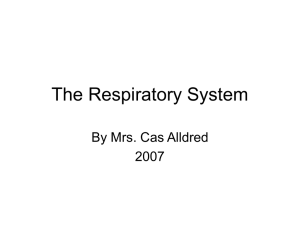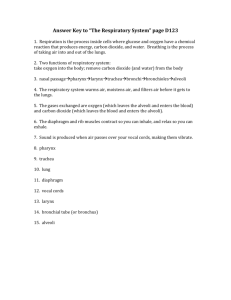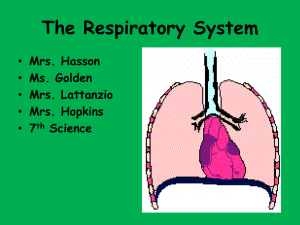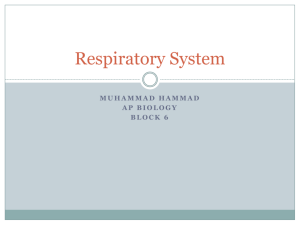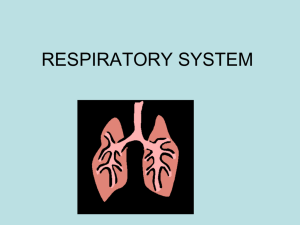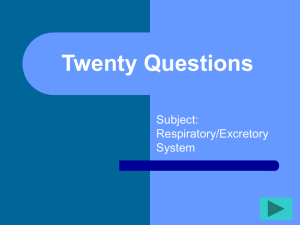11.2: The Human Respiratory System: A Closer Look pg. 450
advertisement
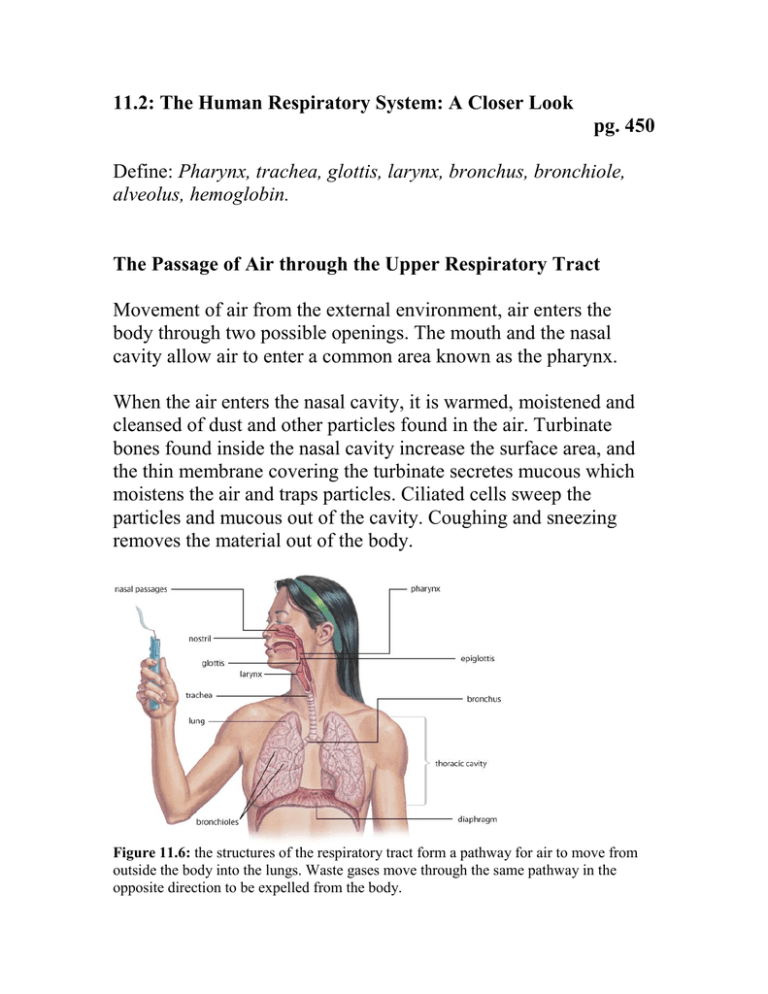
11.2: The Human Respiratory System: A Closer Look pg. 450 Define: Pharynx, trachea, glottis, larynx, bronchus, bronchiole, alveolus, hemoglobin. The Passage of Air through the Upper Respiratory Tract Movement of air from the external environment, air enters the body through two possible openings. The mouth and the nasal cavity allow air to enter a common area known as the pharynx. When the air enters the nasal cavity, it is warmed, moistened and cleansed of dust and other particles found in the air. Turbinate bones found inside the nasal cavity increase the surface area, and the thin membrane covering the turbinate secretes mucous which moistens the air and traps particles. Ciliated cells sweep the particles and mucous out of the cavity. Coughing and sneezing removes the material out of the body. Figure 11.6: the structures of the respiratory tract form a pathway for air to move from outside the body into the lungs. Waste gases move through the same pathway in the opposite direction to be expelled from the body. To warm up the air, the turbinate has an excellent supply of blood, capillaries, the blood has a temperature of 37 0C. The heat is used to warm up the air in the nasal cavity. Cold air can be harmful to the lower respiratory system. This warm air now travels from the pharynx to the trachea, passing by the glottis, which is the top portion of the trachea. The top portion of the trachea is called the Larynx, also known as the voice box where the vocal cords are located. To prevent food from entering the trachea, when swallowing, there is an epiglottis which covers the windpipe this allows the food to slide over the trachea into the esophagus. Larynx The upper portion of the trachea, found between the glottis and the windpipe. The voice box is made up tough and firm connective tissue. This is the area which allows and organism to make noise, humans can talk. During inhaling the vocal cords are held apart, allowing air to pass through freely. When a sound is created the vocal cords are moved closer together. As air passes out of the lungs (exhale), passed the vocal cords, they begin to vibrate creating sound. There are two cords, one longer then the other. The longer one produces a low sound while the shorter one produces a higher sound. The male voice be comes deeper as he matures. The trachea is a tube which is reinforced by cartilaginous rings that maintains it shape. The air passes down the trachea to the bronchi. The lower Respiratory Tract Air moves into the Bronchi. The bronchi branch left and right, transporting air to the left and right lungs. At this time air now is entering the lungs. The right lung consists of three lobes while the left lung only has two lobes and is smaller then the right. This is because of the location of the heart. The lungs are covered by a pleural membrane which is responsible for reducing frictions as the lungs expand. The outer layer of the pleural membrane is attached to the inner rib cage, while the inner layer is covering the lungs. Bronchi branch into bronchioles, which are microscopic tubules. These tubules form a network of tubules which carries air to all locations within the lungs. At the ends of the tubules are found many alveoli. Alveoli sacs are tiny sacs responsible for gas exchange. At the end of the bronchioles the alveoli look like a cluster of small grapes. There is an average of 500 million alveoli found in an adult lung. The alveoli are surrounded by a network capillaries, since the alveoli and capillaries are only a cell thick, diffusion takes place with easy. The alveoli are thin and moist, allowing the diffusion to take place. This is where the respiratory system and circulatory system interact. Oxygen diffuses into the blood vessel and carbon dioxide moves into the alveoli to be expelled. Figure 11.8: Each bronchiole ends in several clusters of alveoli. Surrounding each alveolus is a fine network of capillaries that are part of the circulatory system. Gas exchange occurs between the blood in the capillaries and the air in the alveolus, so that blood leaving the lungs has high oxygen content. Learning Check: questions 13 – 18, page 452. A Detailed Look at Gas Exchange in Humans External Respiration is the movement of oxygen and carbon dioxide between the alveoli and the capillaries. The movements of gases are diffused through the cell membranes easily, because of concentration gradients. The air that enters the alveoli through inhalation has a higher concentration gradient of oxygen than the blood in the capillaries. The capillaries are returning blood back to the lungs after they had delivered oxygen to the surrounding tissues (Internal respiration). At the same time the capillaries are delivering carbon dioxide to the lungs for exchange, diffusion occurs because carbon dioxide concentration is greater in the blood and lower in the alveoli. Figure 11.9: External respiration (a) occurs between the alveoli and the capillaries next to them. Internal respiration (b) occurs between the capillaries and the body tissues. Once the exchange of gases (external respiration) occurs in the lungs the blood carries oxygen to the tissue cells. The cell tissues are low in oxygen and high in carbon dioxide. Internal respiration occurs, oxygen enters the cells, and carbon dioxide leaves the cells and enters the blood. How Blood Transports Respiratory Gases Hemoglobin is protein molecule found in the red blood cell, that enables it to carry 70 times more oxygen then dissolved oxygen in the blood plasma. (99% of oxygen is carry by Hemoglobin and 1% by plasma) Carbon dioxide leaves the tissues and diffuses into the capillaries. 23% is carried by the hemoglobin, and 77% is dissolved in the plasma. Figure 11.10: Hemoglobin binds with oxygen from the lungs and transports it to the body’s tissues. There, the hemoglobin releases enough oxygen to meet the needs of the cells. Section 11.2 Review: questions 1 – 14, page 454

